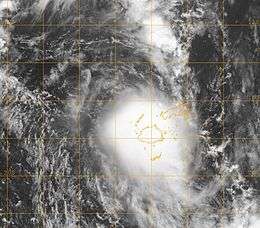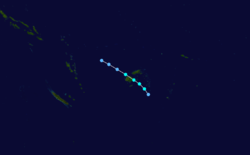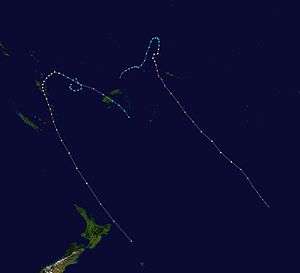Tropical Depression 10F (2004)
Tropical Depression 10F (JTWC designation: 22P) was a small tropical depression that became the deadliest tropical cyclone of the 2004 season, claiming 11 lives in the Fiji islands.
| Tropical depression (Aus scale) | |
|---|---|
| Tropical storm (SSHWS) | |
 Tropical Depression 10F on April 7, 2004 | |
| Formed | April 5, 2004 |
| Dissipated | April 9, 2004 |
| Highest winds | 10-minute sustained: 55 km/h (35 mph) 1-minute sustained: 65 km/h (40 mph) |
| Lowest pressure | 995 hPa (mbar); 29.38 inHg |
| Fatalities | 11 total |
| Damage | $4.17 million (2004 USD) |
| Areas affected | Fiji |
| Part of the 2003–04 South Pacific cyclone season | |
Meteorological history

Tropical Depression 10F was first identified early on April 5 by the Regional Specialized Meteorological Center in Nadi, Fiji as a weak tropical disturbance.[1] The disturbance at this time was located about 700 km (435 mi) to the north of Port Vila, Vanuatu and was embedded within a monsoon trough that extended from the Solomon Islands to the north of Fiji.[1] Major convection around the system was displaced to the north and north east of the low level circulation center.[1] The system was located within a favorable area to develop further with sea surface temperatures of over 30 °C and light vertical windshear.[1]
Preparations and impact
Thousands of tourists holidaying in Fiji were asked to remain indoors while the tropical depression affected Fiji with domestic flights in and out of Fiji canceled.[2] People were also advised not to go out to sea and were advised to take precautions.[2] Public servants were also told to go home after ensuring that emergency procedures were in place, while schools were closed so that students could get home safely.[2]
Tropical Depression 15F brought strong winds heavy rain and flooding to Viti Levu and the Yasawa and Mamanuca group of islands.[2] The depression caused a total of F$5.6 million (US$4.17 million) in damage, while at least 11 people were confirmed dead.[3] Damage and destruction caused by the depression was confined to a thin strip where the tropical depression had passed.[3] Many roads and bridges in Ba and Rakiraki were flooded causing landslides and severe damage to infrastructure and public utilities was reported.[2][3] Family homes were severely damaged or were destroyed by being blown or washed away. Crops were also severely damaged or destroyed.[2][3] The business community also suffered severely as the kings road between Ra and Tailevu was closed to all traffic for several days as parts of the road were washed away.[3] Communications were also severely affected at the height of the storm.[3]
The National Disaster Management Committee of Fiji initially reported on April 11 that seven people had died from the tropical depression with nine people missing.[4]
A woman was swept away while trying to cross the flooded Wainimala River in Naitasiri province, while another women was swept off a flooded bridge in Rakiraki.[5]
By April 12, the Fijian red cross had distributed more than $80,000 F$80 thousand (US$40 thousand) worth of food parcels, however the food parcels were only expected last for two weeks.[6]
See also
- 2003-04 South Pacific cyclone season
- Timeline of the 2003-04 South Pacific cyclone season
References
- "Severe Weather Warnings issued on 2004-04-05". Fiji Meteorological Service. MT Archive. 2004-04-06. Retrieved 2010-06-10.
- "Tropical depression causes flooding in Fiji's west". Radio New Zealand International. 2004-04-08. Archived from the original on 2010-06-13. Retrieved 2010-06-12.
- "Tropical Cyclone Country reports: Fiji 2006-08" (PDF). Fiji Meteorological Service. World Meteorological Organization. Archived from the original (PDF) on March 7, 2012. Retrieved 2010-06-02.
- "Fiji confirms seven dead, nine missing after tropical depression". April 11, 2004 – via NewsLibrary.
- "Two people die in Fiji floods". Radio New Zealand International. April 9, 2004. Retrieved November 24, 2011.
- http://home.nzcity.co.nz/news/article.aspx?id=38488&cat=1032
